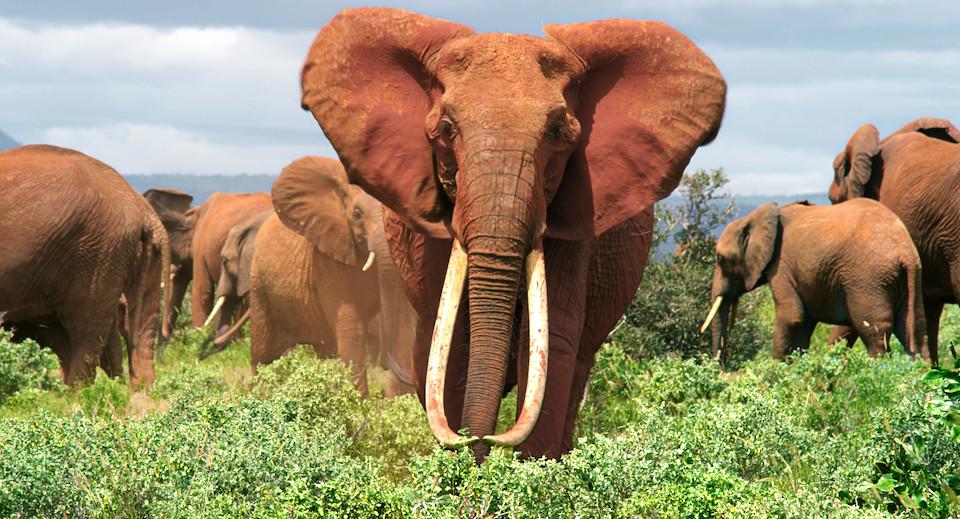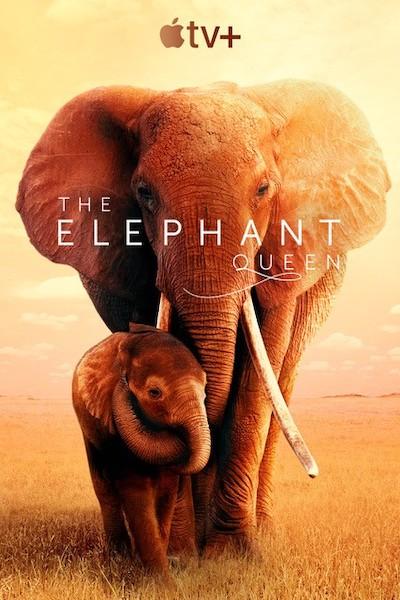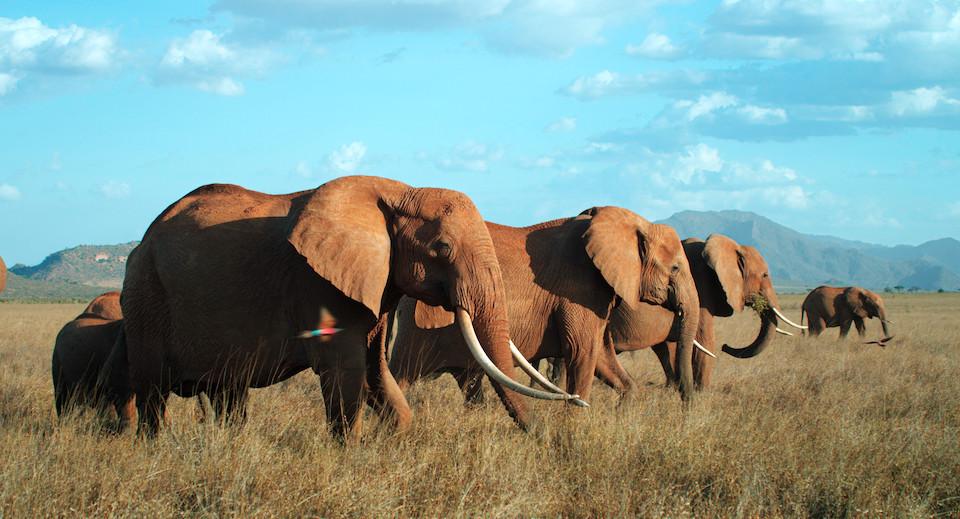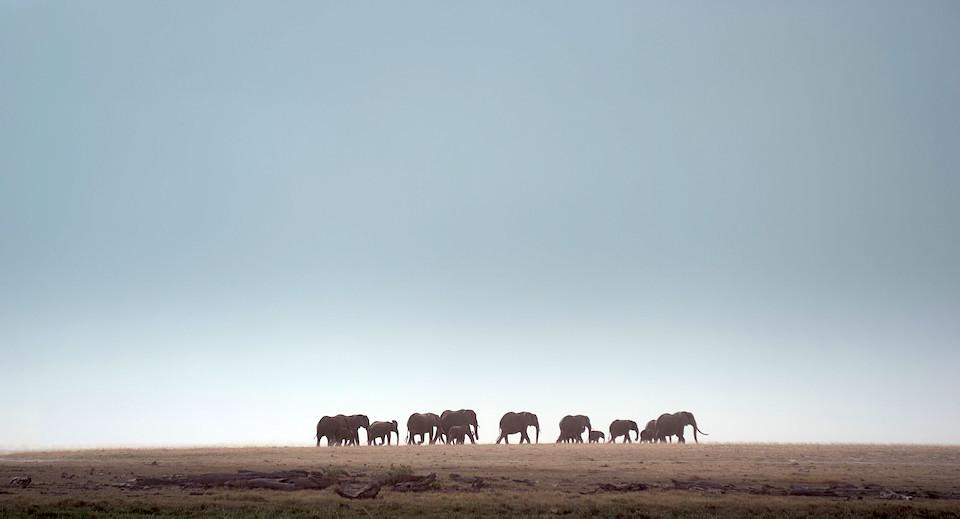
The Elephant Queen/Mark Deeble and Victoria Stone
In this ever seemingly shrinking world, the land and resources that we all share are becoming more and more precious. And making those resources even more valuable are the vagaries of the weather. While some parts of the world are drenched in driving rains, others are mired in drought.
The climate is changing, and the impacts can be deadly not only to humans, but to wildlife. Filmmakers Mark Deeble and Victoria Stone drive that home in their latest film, The Elephant Queen. In it they follow Athena, the matriarch of an elephant herd, as she leads her family from the “kingdom,” a lush landscape during the rainy season, to “the refuge,” where a reliable water hole slakes the thirst of not only these elephants but many others and many other wildlife, from giraffe to zebras to birds.
Filmed in part in Tsavo East National Park in Kenya, the documentary not only focuses on the close-knit elephant herd led by Athena, a 50-year-old “elephant queen,” if you will, but on the various species of wildlife, from killifish and chameleons to bee-eaters and even dung beetles that benefit from the elephants’ presence.
This hour-and-a-half film is captivating both for how we come to know the personalities of Athena and her clan, as well as for the many birds, fish, and animals that rely directly and indirectly on the elephants, and for the sweeping landscape of Tsavo East National Park and the Greater Amboseli Tsavo Ecosystem.
Stone and Deeble, who which have spent the past three decades making nature films above and below water, didn't approach The Elephant Queen as a vehicle to highlight the dangerous impacts of climate change. Rather, they wanted to focus on this iconic animal species, and the landscape they inhabit, and let the viewer draw their own conclusions as to the changes coming to the world around elephants, specifically, and the species that live alongside them. In other words, show, don't tell.
Much of the filming was done in East Tsavo National Park, which forms the largest protected area in Kenya and provides habitat for rhino, lion, leopard, cape buffalo, waterbucks, hippo and other wildlife in addition to elephants. Grasslands and savannah constitute much of the park's landscape.
"When we started this film eight years ago, our ambition was to tell a story that would reach the broadest possible audience across the world," said Stone during a conversation with the Traveler earlier this month. "To inspire the world to fall in love with elephants. It's not a film about climate change, it's not a film about issues. It's a story-driven film to inspire people to care."
"And I think the thing is, that climate change obviously drives the narrative of the film as it were," said Deeble, jumping into the conversation. "We try not to to mention it. The idea is to show what's happening. I think we believe very firmly that if people make the connections for themselves...We talk about how the droughts are going to become more frequent and we show the effects of what's happened. But I think if people see that, and then they make the connection for themselves, then it becomes much more powerful and has the ability to really influence them."

The Elephant Queen is a beautiful, moving film that not only makes a strong connection between the audience and the elephants, but also brings into view many of the creatures that Athena and her family impact that the viewer might otherwise never have really notice. Using a variety of filming techiques, Deeble shows us bullfrogs pictured practically under the elephants’ feed, the interactions between the elephant youngers, Mimi and WeeWee, goslings leaping from their nest to the ground to follow their parents, and even dung beetles in a comical battle over a ball of elephant poop.
"Mark actually did all the cinematography," Stone said. "From underground to in a metal box to flying a plane and filming, and it was just Mark who did it. Really, that's why it takes time. We were four years living alongside elephants in the wild, with a tiny team. There were about five or six of us actually on film work, and a small support team who ran the camp, because we were fairly remote. And that literally meant water was not there, we had to bring it in. And so, you've got no support system, we were reliant on ourselves for everything."
Deeble followed the herd on its migration from the kingdom to the refuge and back again, filming from the ground as well as from a small Cessna he piloted while also managing the camera strapped to a wing. The aerial shots portray Egyptian geese in flight, the elephants as they migrate, the trails they left that turned into creeks during the rainy season that filled the water holes. As the film plays out before us, we almost get to know the personalities of the elephants, from the playfulness of WeWe to the poignant moments where the elephants try to keep MiMi moving, and later when they pause around the skull of an elephant.
"And when it came to the variety of shots," added Deeble, "it was about working it out. For the aerials, that meant strapping a camera to the struts of the old Cessna we used to get around. Things like the killifishes, they looked giant on the screen, but they are tiny in real life. They're barely a millimeter across, and for that, we ended up actually building what's called a macro bench, which is something sort of bolted to a big concrete frame, where you actually move subjects, rather than the camera, because any time the camera pans or something like that it uses too much vibration.
"We did have four years to work all that out. I think what was more difficult was some of the things like the bullfrogs mating. We saw that happen only once in four years. They don't happen every season. They happen when you get enough rain. You need about 3 or 4 inches of rain, and then what happens they come up, they've been incubating underground, what's called their summer sleep, and then they pop up to the surface and then they mate and lay eggs, within hours, and generally all at night."
But the frogs and the killifish and the geese and zebra and giraffe are all supporting cast to the elephants.
"When we start a film like this, we start with the arc of the story," Stone said in explaining the approach they took to be in the right place at the right time for the shots they wanted. "So in this case, the elephants are the providers, they dig the waterholes, they form the channels that then fill the waterholes, they provide the environment and the habitat which affects all the other animals.
"And, then what happens, in the dry season the elephants have to go and they leave their neighbors behind," she went on. "That's literally the simplest structure. We do all the research we can on all the different natural history on all the animals, and then we'll put the time in the field to see what presents itself, what we see, and how we can tell that story. We're kind of working it and evolving it as we see what we get."
The end result is a moving documentary that stimulates us to think about elephants and the plight they face in a world whose climate is changing and where a literal battle for resources often finds them in the crosshairs of a rifle. There are times when you can sense the emotions that flow through the pachyderms. Though we're told not to project human qualities into wildlife, sometimes that can't be escaped when you watch elephants.
"We discussed this a lot in the making of the film -- my background was as a zoologist -- and part of that sort of natural history sort of upbringing is you shouldn't be anthropomorphic when it comes to animals," said Deeble. "But I think more these days that, especially with animals like elephants, it's not necessarily, in my mind, being anthropomorphic, it's more just, we do share common emotions. You spend enough time around elephants, you get to be able to read them. You can tell whether they're happy or they're sad. So I think, in a way for me the whole anthropomorphism question is actually quite anthropocentric. ... These are common emotions. I think to deny them from animals like elephants would do them a real disservice."

From The Elephant Queen/Mark Deeble & Victoria Stone
The filmmakers did not escape human strife during the making of The Elephant Queen.
"As we were filming, the elephant crisis sort of reached a higher pitch, and the price of ivory was rising, the demand for it was rising, and we ended up outside the park literally sharing water holes with poachers," said Stone. "And it reached the stage where we were being completely drawn into it. We were having injured rangers being brought in to camp. Our assistant director, Etienne (Oliff), had to fly two of them out on one incident, and one of them died in the plane. So we were right at the heart of the developing crisis.
"And it was becoming impossible to film the elephants, and so we actually decided we had to go and work in the park. And what was sad but fascinating was that the minute the elephants were in an area that they felt protected, they relaxed," she continued. "You could have the same elephant that would be completely unapproachable outside the park seem like a totally different character inside the park."
Through their years in Africa, Deeble and Stone have seen the climate change.
"I think what's happening is where we used to have droughts and everybody would say this is one-in-a-lifetime or one in 50 years, these droughts are now becoming more and more frequent," said Deeble. "We used to have a very stable weather pattern in East Africa, with long rains and then a period of dry season, and then short rains. You could almost, within a few days, you could predict when the rains would come. And that's now all starting to change. It's not that they don't come, but they are later perhaps, or they come earlier. Sometimes it's usually intense, other times they're sporadic.
"I think the frequency of the droughts and the severity of them is increasing. And in somewhere like Tsavo, which is really an arid country, a lot of the animals are adapted to cope with these extreme dry periods," he said. "But what they're not adapted to cope with is if happen one on the heels of the other. So we are definitely seeing change."
"But also what's happening with that change is that the human-wildlife conflict is becoming more intense," added Stone. "Because the areas that do have water or do have grass or good pasture is needed by both people and elephants. So there's more potential for conflict. That isn't good for anybody, because it's usually elephants that suffer in the long run."
During initial viewings of the film in Kenya, the filmmakers saw that the documentary was having an impact on some viewers.
"One of the reactions that I think exemplifies the importance of showing the film throughout (Kenya), as widely as possible there, is a woman who said afterward, 'You've completely changed my consciousness about elephants through this film'," Stone recalled. "'I used to fear them, I used to hate them, I didn't see why we needed them. I didn't want to include them in my life. You've totally turned my whole feeling on its head. I own some land in central Kenya, I'm going to take down part of the fence, I'm going to welcome them, I'm going to learn to understand them more, I'm going to learn to live alongside them.'
"For us, our original ambition was to reach the broadest possible international audience with an emotional story, but also to make a difference on the ground, and when you get feedback like that, it really makes eight years feel worthwhile."
Traveler postscript:
The Elephant Queen, narrated by Chiwetel Ejiofor, is coming to Apple TV+ in November.
Listen to the interview with Mark Deeble and Victoria Stone in this week's podcast.
Related stories you might find of interest on the Traveler:
The Story Of A Tusk – 28KG / VOI RIVER / 30/5/14
Drone Program Aims To Protect Elephants And Rhinos From Poachers
Kenya’s National Parks: Among The Best Places In The World For Wildlife Observation

From The Elephant Queen/Mark Deeble and Victoria Stone



Comments
My comment is what or how we can assist from having such devastating drought..These are animals are so majestic...isn't there ways we can support them by assisting with water and food ..I saw a documentary where water carrier trucks transport water for animals especially elephants and there are salt ,minerals, and grass..what about bales of hay format for these animals...thanks...There is a G_D WHO LOVES ANIMALS AS WELL AS MAN. AND PLANTS PLEASE TAKE CARE OF THE ANIMALS ESPECIALLY THE LITTLE ONES IN THE DIFFERENT KINGDOMS.: .PLANTS AND ANIMALS KINGDOM
Ruth see the David Sheldrick Wildlife Trust. They have 3 windmills and transport water to different water holes in Tasvo East National Park. Google. I am a member of this group which saves baby elephants who have been orphaned.